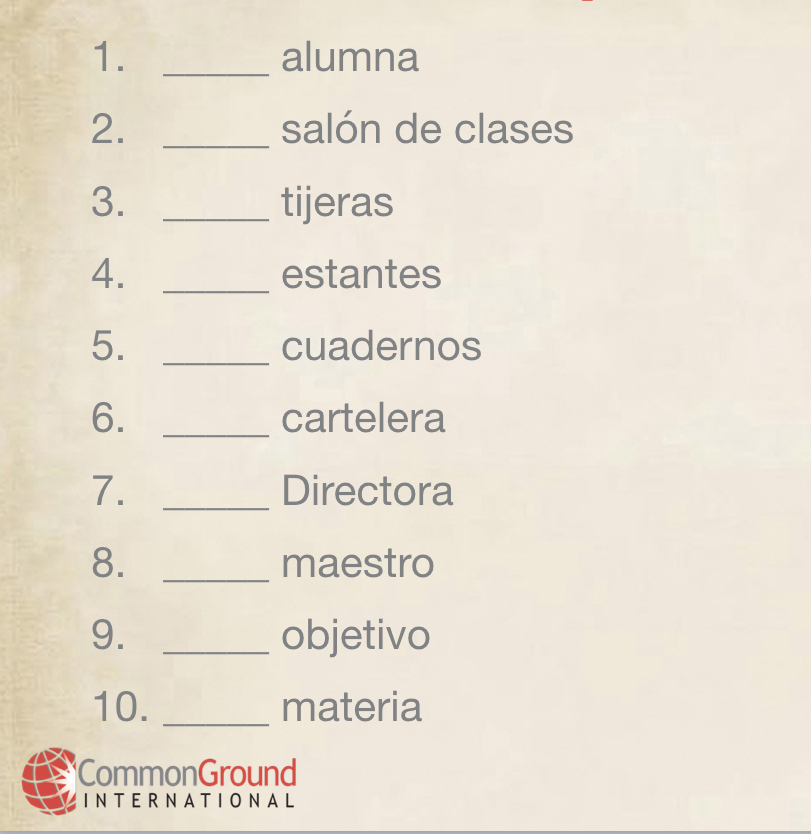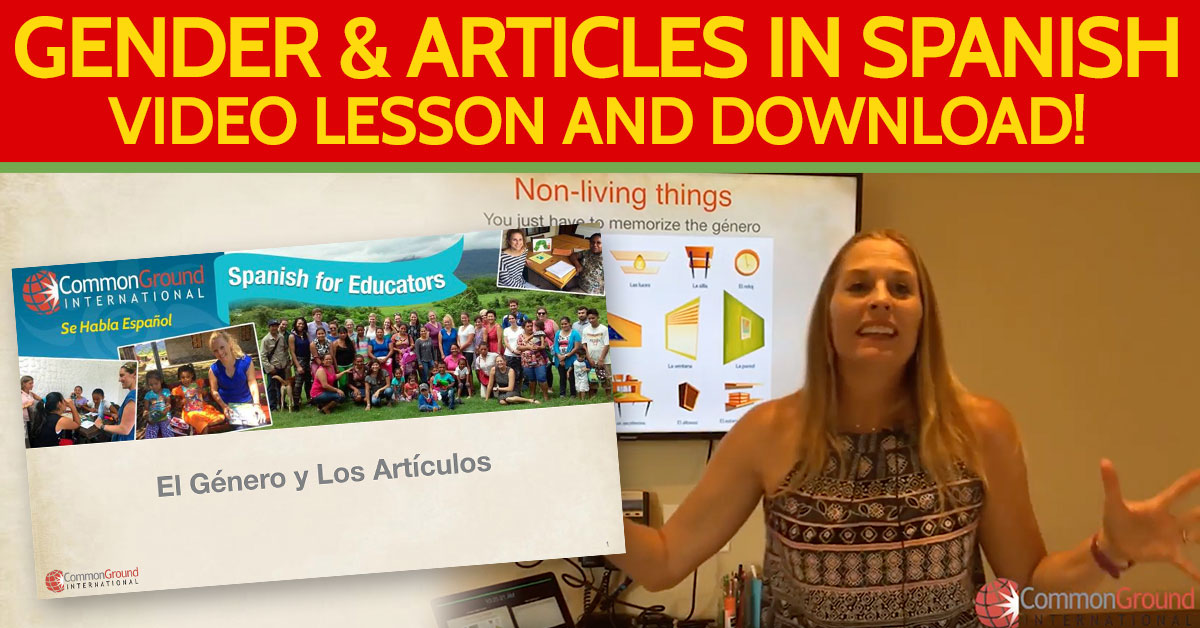Spanish Gender: The Spanish language has gender, it is still a binary language! In this Spanish for Educators lesson you will learn how gender is used to denote a person, place, or thing.
Get ready to master el género y los artículos en español!
Spanish is a gendered language and requires the learner to master which nouns are masculine and feminine and which articles to use with those nouns. The articles must agree in both gender and number (singular or plural). Let’s jump in!
Oh, you should also know- there is a popular waves in some segments of society that are pushing for the use of a gender neutral option in Spanish or el lenguaje inclusivo. I also talk about that current trend and how it is playing out in society!
Su reto profesional: I challenge you to… start using the gender an number properly when talking in Spanish with your Latino students and/or parents/guardians. Don’t worry if you get it wrong, we all do!
Here is the Spanish lesson I taught to my Maestro Miércoles Facebook group:
Subscribe to our YouTube Channel to see all of our lessons and get the latest videos right away!
Objetivos de la lección / Lesson Objectives
In this lesson, educators will learn:
- The concept of gender in Spanish
- How to determine which article to use in communication
- The different types of articles and the agreement between number and gender
- Touch upon expressing classroom supplies using the correct gender and article
- A small introduction to el lenguaje inclusivo in Español
Sounds like too much, right? Don’t worry! This lesson will help you to master these concepts 🙂
¿El Español tiene género? / Does Spanish language have gender?
All nouns in Spanish are either masculine or feminine; and, like in English, they can be expressed in the singular or plural form.
In this case, “escritorio” (desk) is masculine, while “silla” (chair) is feminine. So, for masculine nouns you can use “el” for singular forms and “los” for plural forms. For feminine nouns, you can use “la” for singular forms and “las” for plural forms respectively.
Examples:
Masculine nouns:
- Singular form: el libro, el gato, el carro
- Plural form: los libros, los gatos, los carros
Feminine nouns:
- Singular form: la libreta, la gata, la moto
- Plural form: las libretas, las gatas, las motos
Algunas reglas del género / Some Gender Rules
- Living creatures that end in -O and -A
- Examples: la niña / el niño, el maestro / la maestra
- Living masculine nouns that end in consonants have a corresponding feminine form that ends in -A
- Examples: el profesor, la profesora
- Non- living nouns (you just have to memorize)
- Examples: el marcador, la mochila
- Group of mixed gender – Masculino
- Examples: los niños (boys and girls in this case)
- Some nouns that are professions have same form for masculine & feminine (-ista , -atra rule)
- Examples: el especialista, la especialista, el psiquiatra, la psiquiatra
- Nouns that end in –sión, –ción, –dad, –tud and –umbre will always require the feminine article
- Examples: la lección, la universidad, la visión, la actitud, la cumbre
- Most nouns that end in –ma are masculine
- Examples: el problema, el dilema
- !!!Siempre hay excepciones!!!
- Examples: la mano, el día, etc. 😀
Let’s see more examples of these gender rules
1. Nombres de criaturas vivas / Living creatures
These nouns have their corresponding masculine and feminine forms. Form some nouns ending in “e” you only need to change the article:
2. Criaturas vivas que terminan en consonante / Living Creatures that end in a Consonant
These nouns have their corresponding feminine form ending in “a”:
3. Cosas inanimadas / Non Living Things
In this case, you need to memorize the gender (sorry about that)
- La mochila / Las mochilas
- El reloj / Los relojes
- La pizarra / Las pizarras
4. Sustantivos que terminan en… son femeninos / Nouns that end in… are feminine
The majority of nouns with these endings are feminine, so be sure you are using the proper article when talking:
Ending |
Example |
|---|---|
| -dad |
La igualdad de los derechos humanos para todos |
| -tad | |
| -tud |
La actitud correcta para aprender |
| -sión | |
| -ción |
La creación de puestos de trabajo |
| -umbre |
La costumbre de Día de los Muertos |
5. Muchos sustantivos que terminan en -ma son masculinos / Many nouns that end in -ma are masculine
- El problema – The problem
- El dilema – The dilemma
- El tema – The topic
- El idioma – The language
- El programa – The program
- El sistema – The system
- El poema – The poem
- El clima – The weather
6. ¡Siempre hay excepciones! / There Are Always Exceptions!!!
Spanish language also has its own exceptions, so the rules don’t always apply. Here are some examples:
Exception |
Example |
|---|---|
| La mano | |
| El día |
Durante el día escolar, tenemos 8 clases |
| La fuente |
La fuente del parque está funcionando otra vez |
| La imagen |
Los artículos en Español / The articles in Spanish
There are 4 ways to say THE in Spanish, and each of them depends on the gender of the noun (masculine or feminine) and the number (singular or plural). There are two types or articles: the definite and the indefinite.
El artículo definido / The Definite Article
- El: Masculino singular. Example: El marcador (The marker)
- La: Femenino singular. Example: La botella de agua
 (The water bottle)
(The water bottle) - Los: Masculino plural. Example: Los lápices (The pencils)
- Las: Femenino plural. Example: Las tijeras
 (The scissors)
(The scissors)
El artículo indefinido / The Indefinite Article
This article is used to express “a”, “an” or “some”. Similar to the definite article, the indefinite one also depends on the gender and number of the noun.
- Un: Masculino singular. Example: Un marcador (A marker)
- Una: Femenino singular. Example: Una botella de agua
 (A water bottle)
(A water bottle) - Unos: Masculino plural. Example: Unos lápices (Some pencils)
- Unas: Femenino plural. Example: Unas tijeras
 (Some scissors)
(Some scissors)
¡Ahora te toca a ti! / Now it’s your turn!
Study all of this classroom vocabulary in Spanish with these flashcards!
Solve the following exercises using the right gender and number with each noun:

Share your answers in the comments below or on our Facebook group to receive feedback from other teachers!





